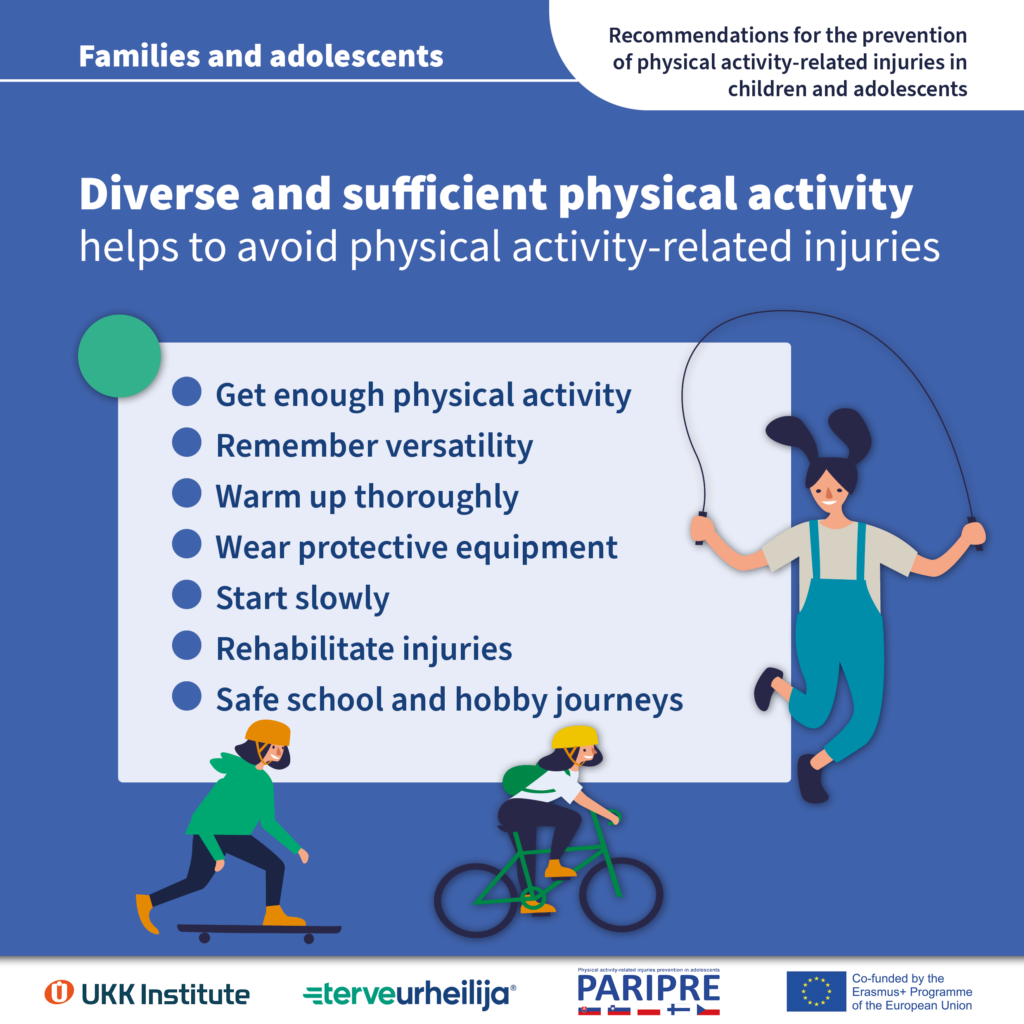Recommendations for the prevention of physical activity-related injuries
State and government
- Governing bodies should ensure continuous, nation-wide injury monitoring to measure the public health burden of PA related injuries and to estimate the effect of prevention actions.
- Sports disciplines should be integrated to ICD-11 injury codes.
- Sufficient resources should be directed to physical activity-related injuries prevention along with the PA promotion.
Sports associations and sports clubs
Implementation of neuromuscular training warm-up
- Neuromuscular training warm-up should be a part of training routines in children and adolescents from age 7 forward.
- Children and adolescents’ organized training should include neuromuscular training routines 2–3 times per week, 15–20 minutes at a time, year-round, and with adequate progression and variety in exercises.
- Neuromuscular training warm-up should be instructed by a coach or physiotherapist, who has been trained to neuromuscular training.
- In addition to multicomponent neuromuscular training warm-up procedures, sport and exercise specific neuromuscular training should be included to prevent certain sports injuries in high-risk sports. These include:
- balance/proprioceptive exercises to prevent ankle sprains,
- strength and movement control exercises (i.e. cutting and landing technique training) to prevent knee injuries,
- eccentric strength training to prevent muscle injuries,
- strength and stabilization exercises to prevent shoulder injuries.
Equipment
- Children and adolescent athletes should always use available and appropriate protective equipment designed for each sport.
- Helmets with full-facial protection, mouth guards, and protective eyewear should be mandatory for youth athletes in sports where the risk of head and orofacial injuries, concussions, and eye injuries is high. Use of wrist supports can reduce the number of wrist injuries in snowboarding, and likely in other similar type of sports such as skateboarding and roller blading. Use of ankle support or taping is recommended for youth athletes with previous ankle injuries, especially during early phases of recovery. External knee supports may also help prevent re-injury in knee injured athletes. However, use of external joint supports should not exceed the importance of neuromuscular training in youth athletes. Finally, sufficient shoe cushioning decreases the risk of overuse injuries.
Rules and regulations
- Helmets with full-facial protection, neck guards, mouth guards, and protective eyewear should be mandatory for youth athletes in high-risk sports.
- Rule modifications, such as disallowing body checking in youth ice-hockey, should be considered in contact youth sports, where the risk of severe injuries is high.
- Harder sanctions should be given for head-checking.
- Regulations that restrict the number of competitions per week should be considered in certain youth sports to ensure sufficient rest and recovery for adolescent athletes.
- Education on sports injury prevention should be mandatory for all coaches in youth sports.
Load management
- Training program of children and adolescents should include diverse training that considers
a) the phase of physical development individually, and
b) balanced loading of different organ systems (cardio-vascular, musculoskeletal, and nervous system). - Repetitive exercises causing high stress to immature skeleton should be avoided and replaced with less straining activities especially during the rapid growth and in case the athlete experiences symptoms.
- Youth athletes should be encouraged to physically active lifestyle also outside sport training.
- Adequate amount of rest and sleep as well as sufficient nutrition should be ensured.
- Training load (duration, frequency and intensity) of elite level youth athletes should be monitored, and rapid changes in training load should be avoided.
- Early specialization in single sport should be avoided.
Injury rehabilitation
- Treatment and rehabilitation of sports injuries should be guided by a sports physician and/or sports physiotherapist, and ideally, involve other relevant professionals (such as strength and conditioning coach, biomechanist, kinesiologist, psychologist).
- Available evidence-based return-to-play consensus and guidelines should be used to assess readiness to return to competition.
Environment
- Suitable friction and cushioning of the playing surface, flexibility of the rink materials as well as safety of the surroundings should be taken into account when planning and reconstructing sports facilities.
- Signs and posters that remind from proper warm-up, equipment and rules could be placed to sporting venues.
Schools and teachers
Implementation of neuromuscular training warm-up
- Teachers are recommended to deliver the neuromuscular training warm-up program as the minimal standard of practice for injury prevention in youth sport and recreation in school physical education classes (ages 11–16).
- The neuromuscular training warm-up should include aerobic, agility, strength, and balance exercises, and the duration of the warm-up should be approximately 15 minutes at a time.
Education and counseling of safety in sports
- Education of sports and leisure time safety (rules, equipment, behavior) should be included in the curriculum of school physical education in all 12 to 15-year-old students.
Families, children, and adolescents

- Adolescents should participate in moderate- to vigorous-intensity, mostly aerobic, physical activity at least on average 60 minutes per day across the week. Adolescents should incorporate vigorous-intensity aerobic activities, as well as those that strengthen muscle and bone, at least 3 days a week, and also limit the amount of sedentary time.
- Regular participation in activities requiring strength, balance, coordination, and agility, can help reduce the risk of PA related injury, and is recommended for all adolescents.
- Early specialization in single sport can increase the risk of sports injuries and hence, should be avoided.
- New physical activities and sports are recommended to be started gradually.
- Every sport session, which includes running, sprinting, kicking, throwing or other rapid or intense movements, should start with a proper warmup and with moderate intensity.
- Guardians of the children and adolescents should ensure that they have and wear good quality equipment and protectors to decrease the risk of severe injuries.
- In case of an injury, adequate rehabilitation should be ensured to avoid re-injuries or other injuries.
- The highest risk of fatal injury exists when commuting to school and leisure time activities, and thus, issues of safe routes and traffic safety should be acknowledged and guided by the guardians.
Last updated: 13.3.2025
